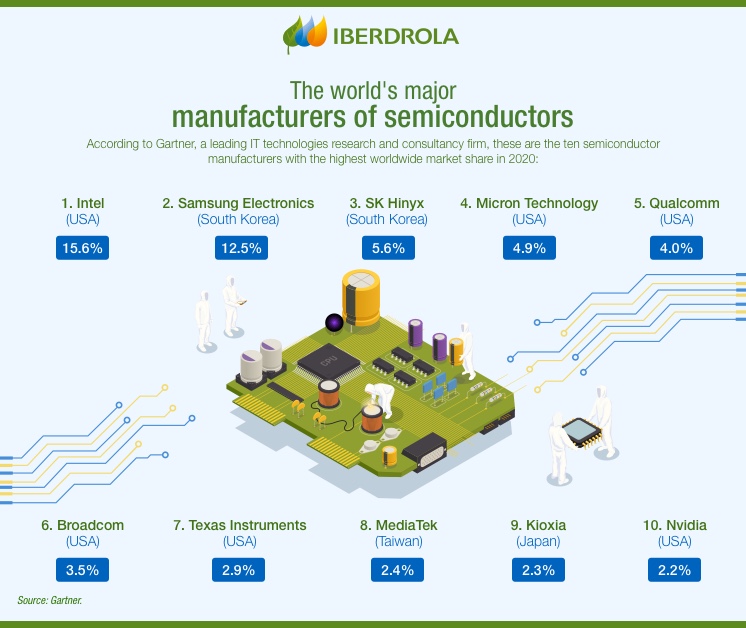Semiconductors
Semiconductors, what are they and why is their scarcity threatening the world economy?
The semiconductor crisis, which can briefly be described as a scarcity of chips, has caused an upheaval in numerous sectors of the economy — from consumer electronics to the automotive industry and domestic appliances —, to the point that large companies have had no option but to cease production. The best way to gain a better understanding of what has happened and why is to know exactly what semiconductors are and how they are made.

Can you imagine it suddenly being impossible to manufacture more smartphones? How would this affect a society that is increasingly dependent on these devices? Although this may come across like the storyline of a dystopian novel, it could well become a reality if are unable to manufacture more microchips. This is why the current semiconductor crisis is causing such concern, keys in its elaboration.
And it's not only smartphones, that are in the line of fire, but also computers, domestic appliances, cars, etc. We are increasingly surrounding ourselves with more devices and appliances fitted with microchips that make our lives easier. These tiny electronic brains mounted on semiconductor materials have come to form an essential part not only of our daily lives, but also of how we conduct our business and industrial activities.
THE SEMICONDUCTOR STOCKS CRISIS
According to consultancy firm IDC, during the first quarter of 2021, worldwide sales of computers grew by 55 % compared with the same period of 2020. It goes without saying that this spectacular increase is due to the increase of homeworking, of online learning and of digital leisure caused by the pandemic. Figures show that demand for electronic devices in general had already gone through the roof during the 2020 lockdown, and since then there has been no letup.
Furthermore, several sectors that depend on microchips are currently booming, such as the production of graphic cards for the mining of certain cryptocurrencies — for example, Bitcoin —. And, likewise, many classic industries are demanding ever more of these electronic components, such as the automotive sector, for which microchips are now essential when it comes to manufacturing conventional and electric vehicles due to the improved safety levels they enable.

SEE INFOGRAPHIC: The world's major manufacturers of semiconductors [PDF] External link, opens in new window.
All of this means that the operations of the semiconductor factories, which also had to shut down during lockdown, have been limited since they reopened and that they are facing up to their own supply problems, resulting in them being swamped by the demand. As a result, the automotive, domestic appliance and IT industries, among others, have been forced to cut back their production.
In response to this, Intel has already announced that it is going to invest 20 billion dollars in two new factories in Arizona (USA). China and the European Union have also stated their intention to open factories in order to offset the scarcity of semiconductors. However, it takes time for facilities of this type to enter production due to the complexity of the microchip manufacturing process, meaning that the crisis could well persist in the short term.
WHAT IS A SEMICONDUCTOR
A semiconductor is any material which, depending on the circumstances — temperature, pressure, radiation and magnetic fields —, can act as a conductor, thus allowing the current to pass, or as an insulator, thereby preventing it from passing. Semiconductors, therefore, differ from conductors in that they can perform both functions simultaneously. At present, the most commonly used semiconductor is silicon, especially in the electronics and IT industry, as it is the most naturally abundant and the one that performs best at high temperatures.
TYPES OF SEMICONDUCTOR
Semiconductors are classified in two types depending on their purity:
- Intrinsic: these are pure, as their molecular structure consists of only one type of atom, such as silicon, germanium, tin, selenium or tellurium.
- Extrinsic: those to which impurities are added in a process known as doping, the purpose of which is to increase the conductivity of the materials.
When an intrinsic semiconductor is doped with impurities, two types of extrinsic semiconductor can be obtained:
- P type: when a tetravalent atom (such as silicon) is doped with another trivalent (such as aluminium, boron or gallium), there are three electrons for four covalent bonds. This forms a gap through which the electrons that give rise to the electrical current can flow. Due to the positive charge of the gap, they are identified using the letter P.
- N type: these are formed by doping a tetravalent atom (such as silicon) with another that is pentavalent (such as phosphorous, antimony or arsenic). On having five electrons and four covalent bonds, one electron with a negative charge, hence the letter N, is free to move via the crystalline lattice, thus increasing the conductivity of the intrinsic semiconductor.
SEMICONDUCTOR EXAMPLES (APPLICATIONS)
The main applications of semiconductors include:
- Transistors: these are electronic devices capable of modifying an outgoing electrical signal in response to an incoming one, thus serving as amplifiers, switches, oscillators or rectifiers thereof. They are commonly used in radios, clocks and light fittings, among other appliances.
- Circuits: also known as chips or microchips, these are electronic circuits whose components are arranged in a sheet of semiconductor material, today they are a key component in devices such as computers, tablets and mobile phones, etc.
- Diodes: these have multiple applications, the most evident of which is converting alternate current into direct. Hence their use in photovoltaic panels, which convert the sun's energy into electricity, as well as LED.




